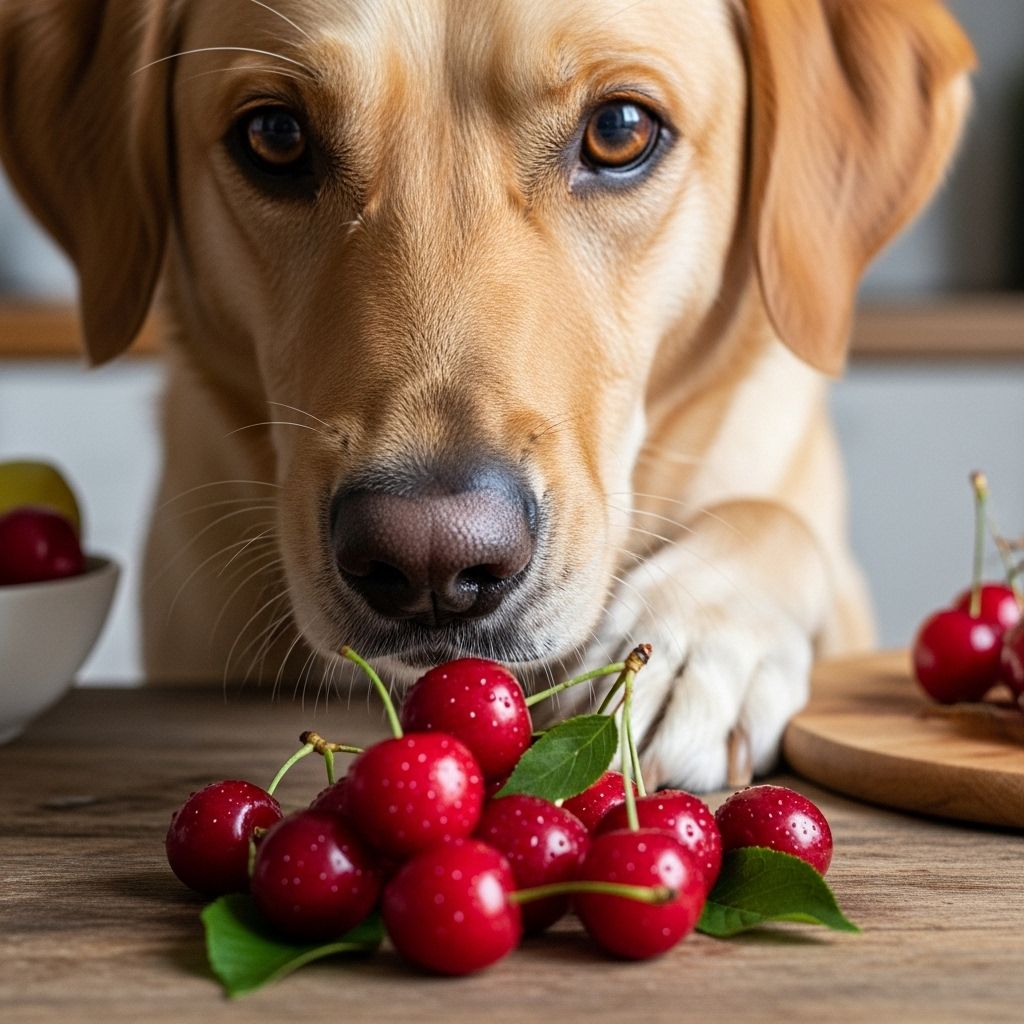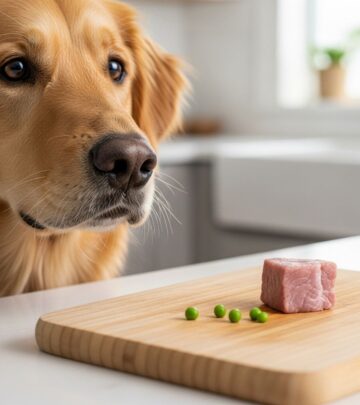Can Dogs Eat Cherries? Safety, Risks, and Healthy Alternatives
Explore the potential risks, nutritional benefits, and veterinary advice on feeding cherries to dogs.

Can Dogs Eat Cherries?
Cherries are a beloved summertime snack for people, but when it comes to dogs, this fruit isn’t always a safe or suitable treat. The question of whether dogs can eat cherries is complicated: while the flesh of the fruit is not toxic, the pits, stems, and leaves pose significant health hazards for dogs and often make cherries more dangerous than beneficial for your canine companion.
Are Cherries Safe for Dogs?
Yes and no. While the actual flesh of the cherry is not toxic to dogs, almost all other parts of the cherry—especially the pits, stems, and leaves—contain cyanogenic compounds that release cyanide, which is poisonous to dogs if chewed or ingested in sufficient quantity.
It’s only with careful removal of the pit, stem, and leaves that the fruit might be safely offered—though most veterinarians do not recommend cherries as a snack due to the risk of accidental ingestion of these toxic parts.
Quick Overview Table: Cherries and Your Dog
| Cherry Part | Safe for Dogs? | Risks |
|---|---|---|
| Flesh | Yes (in small amounts) | Potential digestive upset |
| Pit | No | Cyanide poisoning, choking, intestinal blockage, dental injury |
| Stem/Leaves | No | Cyanide poisoning |
Health Benefits of Cherries for Dogs
The flesh of cherries, if carefully prepared and provided in very small amounts, does contain nutrients that can be good for dogs. These include:
- Antioxidants: Protect cells from free radical damage and may reduce the risk of chronic diseases.
- Vitamins A, C, and E: Support immune system function, vision, skin, and overall health.
- Melatonin: Present in tart cherries, may help regulate natural sleep cycles.
- Fiber: Supports healthy digestion and gut function.
- Potassium: Important for heart and muscle function.
- Low calorie and low fat: Cherries have fewer calories compared to many dog treats.
However, the risks presented by cherries greatly outweigh these benefits, and many safer fruits provide similar nutrition without the hazards.
Better Alternatives to Cherries for Dogs
- Blueberries
- Bananas
- Apples (no seeds or core)
- Pineapple
- Cantaloupe
These fruits offer antioxidants, vitamins, and fiber, and can be easily prepared without risk of toxicity or physical harm.
Dangers of Cherries for Dogs
Cyanide Poisoning
Cherry pits, stems, and leaves contain cyanogenic glycosides, which are compounds that release cyanide when chewed. Cyanide is a potent toxin that interferes with the body’s ability to use oxygen, leading to serious symptoms and potentially quick death, especially in small dogs or puppies. Toxicity can result from a handful of chewed pits or even fewer for smaller breeds.
Signs of cyanide poisoning in dogs include:
- Dilated pupils
- Rapid or difficulty breathing
- Bright red gums
- Panting
- Weakness
- Shock
- Agitation and restlessness
- Seizures
- Drooling and confusion
Symptoms can appear within 15–30 minutes after ingestion of chewed pits, stems, or leaves.
If you suspect your dog has ingested these parts of a cherry or is displaying any of these symptoms, seek veterinary care immediately.
Choking and Intestinal Obstructions
- Cherry pits are the perfect size to block a dog’s airway (especially small breeds and puppies).
- If swallowed whole, pits can get lodged in the digestive tract, causing a life-threatening obstruction.
- Chewing pits can cause dental fractures or broken teeth.
- Physical blockage symptoms: vomiting, abdominal pain, loss of appetite, low energy, or constipation.
While a single pit is unlikely to cause cyanide poisoning, it remains dangerous due to the potential for blockage or dental damage.
Digestive Symptoms
- The flesh of cherries, although not toxic, can lead to vomiting or diarrhea in some dogs due to high fiber and sugar content.
- Large quantities or sudden introduction into the diet increase the likelihood of GI upset.
Dental Risks
- Cherry pits are extremely hard and can fracture teeth if chewed.
Can Dogs Eat Cherries Without the Pit?
Technically, yes, a very small amount of cherry flesh with the pit, stem, and leaves carefully removed can be offered. However, experts and veterinarians generally discourage feeding cherries to dogs due to the high risk that even a small amount of pit or stem could be accidentally ingested. If you choose to feed your dog cherries, exercise extreme caution and consult your veterinarian first.
How to Safely Feed Cherries to Your Dog
If you still wish to offer a tiny amount of cherry as a treat:
- Rinse cherries thoroughly.
- Manually remove the pit, stem, and any leaves.
- Cut the fruit into small pieces to avoid choking.
- Feed only a slice or two and watch for symptoms of GI upset.
Never offer dried or processed cherry products, maraschino cherries, cherry-flavored foods, or artificial cherry flavoring.
What Should I Do If My Dog Ate a Cherry (or Cherry Pits)?
What you do depends on how much and which parts your dog consumed:
- Only cherry flesh in a small amount: Watch your dog closely for signs of digestive upset or allergic reactions.
- Cherry pit, stem, or leaf ingestion (chewed or unchewed): Call your veterinarian or an emergency vet clinic right away, especially if you have a small dog.
- Watch for symptoms: Difficulty breathing, dilated pupils, red gums, vomiting, lethargy, or any sudden behavioral change.
If your dog swallowed cherry pits and is not immediately symptomatic, monitor for indications of gastrointestinal blockage, such as repeated vomiting, pain, or changes in stool. Even without toxicity, blockages are emergencies.
Key Takeaways: Should You Feed Cherries to Your Dog?
- Safer fruits are available. Blueberries, apples (no seeds), and bananas offer similar benefits without the risk.
- Cherry pits, stems, and leaves are hazardous. Dog owners are strongly advised to avoid giving cherries in any form where these might be ingested.
- If your dog eats any toxic part of a cherry, seek veterinary help immediately.
- Always consult your veterinarian before introducing new foods.
Frequently Asked Questions (FAQs) About Dogs and Cherries
Q: Can dogs eat maraschino cherries, dried cherries, or cherry-flavored products?
A: No, these are unsafe. They often contain high amounts of sugar, additives, preservatives, or artificial sweeteners toxic to dogs, such as xylitol.
Q: Will one cherry pit harm my dog?
A: A single pit is unlikely to cause cyanide poisoning but can cause a choking hazard or potentially a digestive tract blockage, especially in smaller breeds.
Q: What should I do if my dog just swallowed some cherry stems or leaves?
A: Contact your veterinarian immediately, especially if you notice any symptoms of poisoning or behavioral changes within the first 30 minutes after ingestion.
Q: Are cherries ever recommended for dogs by veterinarians?
A: Most vets recommend against offering cherries due to risk. There are other fruits with the same nutritional value and none of the toxicity risks.
Q: What fruits can I give my dog instead?
A: Blueberries, banana, peeled and seeded apples, cantaloupe, and pineapple are all dog-safe fruits to try.
Summary Table: Can Dogs Eat Cherries?
| Item | Is It Safe? | Notes |
|---|---|---|
| Cherry Flesh | Yes (but not recommended) | Risks still exist if pit, stem, or leaf residue remains |
| Cherry Pit | No | Cyanide, choking, intestinal obstruction |
| Cherry Stem/Leaves | No | Cyanide toxicity risk |
| Cherry-Flavored Foods | No | Could contain xylitol or other toxic ingredients |
Conclusion
Though cherries may seem tempting to share with your dog, the health hazards—especially cyanide poisoning and physical blockages—are significant. For your pet’s safety, avoid giving your dog cherries and opt for safer fruits as a treat. Always consult your veterinarian with any dietary questions or if your pet has eaten part of a cherry plant.
Read full bio of Sneha Tete












